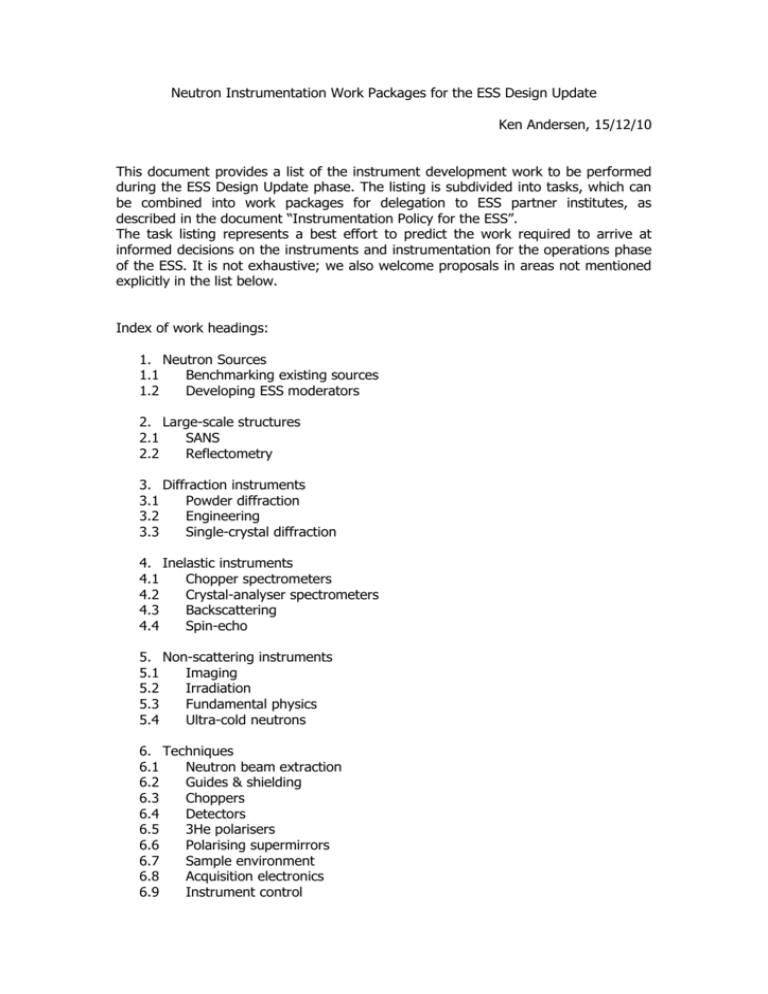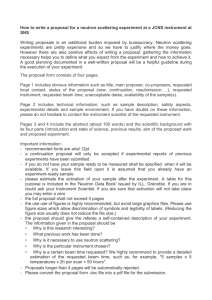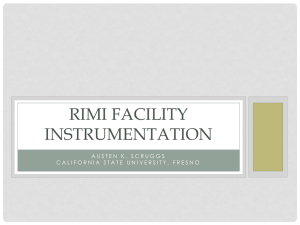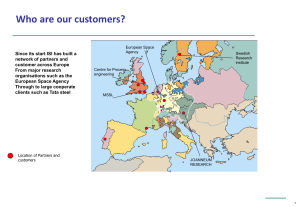Instrument Work Package ideas
advertisement

Neutron Instrumentation Work Packages for the ESS Design Update Ken Andersen, 15/12/10 This document provides a list of the instrument development work to be performed during the ESS Design Update phase. The listing is subdivided into tasks, which can be combined into work packages for delegation to ESS partner institutes, as described in the document “Instrumentation Policy for the ESS”. The task listing represents a best effort to predict the work required to arrive at informed decisions on the instruments and instrumentation for the operations phase of the ESS. It is not exhaustive; we also welcome proposals in areas not mentioned explicitly in the list below. Index of work headings: 1. Neutron Sources 1.1 Benchmarking existing sources 1.2 Developing ESS moderators 2. Large-scale structures 2.1 SANS 2.2 Reflectometry 3. Diffraction instruments 3.1 Powder diffraction 3.2 Engineering 3.3 Single-crystal diffraction 4. Inelastic instruments 4.1 Chopper spectrometers 4.2 Crystal-analyser spectrometers 4.3 Backscattering 4.4 Spin-echo 5. Non-scattering instruments 5.1 Imaging 5.2 Irradiation 5.3 Fundamental physics 5.4 Ultra-cold neutrons 6. Techniques 6.1 Neutron beam extraction 6.2 Guides & shielding 6.3 Choppers 6.4 Detectors 6.5 3He polarisers 6.6 Polarising supermirrors 6.7 Sample environment 6.8 Acquisition electronics 6.9 Instrument control 6.10 Data visualisation, reduction and analysis List of individual tasks: 1.1 Benchmarking of Existing Neutron Sources: 1.1.1 Assemble existing data on neutron source brightnesses. Assembling, evaluating and sorting published and non-published measurements from existing neutron sources. The survey should aim to include all neutron sources from the following labs: ILL, FRM-II, ISIS, SNS, HFIR, J-PARC, Lujan Center. 1.1.2 Fill in the gaps where no data can be found. Where no measurements can be found, perform the measurement. There are several ways to do that: measurement of a standard sample on an instrument, followed by guide simulation up-stream gold-foil measurements combined with an independent spectral determination, which could be a calculation ideally a TOF measurement with a calibrated detector. 1.1.3 Comparison with simulations. Comparing the obtained spectra with simulation results to ensure that we are able to predict moderator performance. This task falls within the domain of the ESS Target Division, rather than the Instruments Division. 1.2 Developing ESS moderators. X There are several tasks under this heading, which all fall within the domain of the ESS Target Division. 2.1 Small-angle Neutron Scattering 2.1.1 Small-sample SANS instrument This is the first of the two types of SANS instrument proposed by the SAC: a very short (8+2+2m) instrument for small samples and with a very large Q-range in a single measurement. It is optimised for 2x2mm2 samples and has a detector at only 12m from the target. One of the main concerns with this instrument is the ambient background for an instrument which is so close to the source. MCNP or another neutronics package is needs to examine this problem. Direct line-of-sight from the source to the sample needs to be eliminated. Solutions for in-pile optics need to be evaluated. The instrument will probably have no choppers. The performance of a long-wavelength cutoff filter needs to be evaluated. 2.1.2 Flexible SANS instrument X An instrument which will allow larger samples and access to smaller Q with a better wavelength resolution. About 6+12+12m long, for samples of up to 10x10mm2. The reduction in wavelength range caused by the increased length will need to be compensated by a larger of more flexible detector arrangement, coupled with more sophisticated beam optics. 2.1.3 SANS instrumentation and concepts The headings below cover several areas of expertise, and may be distributed over more than one work package: Polarisation analysis using polarised 3He Lenses Mirrors Stroboscopic TISANE measurements Grazing-incidence SANS X Multi-beam SANS Spin-echo SANS 1D “Kratky-camera” SANS Extreme environments for SANS X 2.2 Reflectometers 2.2.1 Horizontal reflectometer for soft matter and biology X The sample is horizontal for studies of free surfaces and liquid-liquid interfaces on biological and soft-matter samples. The beam should allow sample sizes of up to 4x4cm2. The instrument is very short: 10m from source to sample, and 2m from sample to detector, giving a very large dynamic range with low wavelength resolution. The beam should be strongly focusing in the horizontal direction, using e.g. an elliptical guide. Different beam optics for the vertical direction should be considered, such as a parabolic mirror or a conventional pin-hole arrangement. The vertical optics need to move the sample out of direct line-of-sight of the source and also eliminate the longest wavelengths. The incidence angle needs to be adjustable up to +/- 4 degrees, to cover length scales in the sample between 10Å and several 100Å. As for the short SANS instrument, extra attention will have to be paid to reducing background so close to the target station. The instrument should have a polarised beam for magnetic contrast variation. 2.2.2 Vertical reflectometer for hard condensed matter X This instrument is optimised for small samples (<5x5mm2), covering a wide Q-range of 0.01 to 0.4 Å-1, and able to probe very thin layers with medium to low Qresolution (5-20%). It must be equipped with polarisation analysis. The length and layout of the instrument remains to be defined. The Selene concept appears promising, but other layouts also need to be considered. 2.2.3 Reflectometry instrumentation and concepts The headings below cover several areas of expertise, and may be distributed over more than one work package: Off-specular polarisation analysis using polarised 3He Grazing-incidence SANS Multi-beam reflectometry Large-divergence reflectometry using sample as pin-hole Prisms Larmor-precession methods for reflectometry (e.g. SERGIS) X 3.1 Powder Diffraction 3.1.1 General-purpose powder diffractometer X This is a medium-length (30-50m) instrument, along the lines of GEM, using a pulseshaping chopper to provide a flexible resolution together with multiple frame multiplication to fill the time frame. It views a thermal source and comprises several detector banks, each of which produces data over a large range of Q, but with different resolutions. The instrument is not expected to be the most optimum way of building a powder diffractometer at the ESS, but represents an important baseline reference to which other designs can be compared. The resolution is that required for general Rietveld refinement, which is of the order of 0.2% d/d. 3.1.2 Narrow-bandwidth powder diffractometer A thermal 200m instrument with a pulse-shaping chopper. Due to the length of the instrument, the wavelength range is rather small, and the Q-range is determined by the angular coverage of the instrument, making it “angle-dispersive”, rather than “wavelength-dispersive”. The detector bank thus needs to be continuous to ensure a continuously-varying resolution function, but the shape remains to be optimised. Resolution requirements as for the general-purpose diffractometer . 3.1.3 Crystal-monochromator powder diffractometer A stack of monochromator crystals with different d-spacings would focus the beam on to the sample with an equatorial D20-type detector on one side. The different dspacings of the monochromator would be separated by time-of-flight, but each data set would resemble that of a continuous-source instrument. A thermal spectrum is needed. In addition to the analytical and simulation optimisation work, development work would be required to optimise the construction and performance of the multiplexed crystal monochromator. 3.1.4 Production and treatment of real & virtual data The performance metric of all the powder diffractometers is the quality of the Rietveld refinement that can be performed on the data. It is thus essential that all the instruments be modelled to a sufficient level of detail to allow the production of virtual data which should then be exported and treated using the same programs as currently used for real data, to produce refineable diffractograms which will then serve to make quantitative evaluation of the instrument performance. Of particular interest is the question of the quality of data produced by merging data sets taken with different chopper phasings for the general-purpose diffractometer. This can be done using both discrete chopper phases or continuously slewing the choppers. In both cases, the normalisation quality of the merged data set needs to be evaluated. This requires the development of new data reduction routines which can be applied to both real and virtual data. A test beam which will allow the production of real data for this machine geometry would be of great interest. X 3.1.5 Powder diffraction instrumentation and concepts The headings below cover several areas of expertise, and may be distributed over more than one work package: Large-area detectors with good efficiency, sufficient anisotropic spatial resolution and counting-rate capability, at a price allowing coverage of a very large fraction of 4pi. See detector task. Modular guide and other focusing concepts allowing trade-off between divergence and flux for various sample sizes. See focusing guide task. Rapid sample changing. A very-high-flux workhorse powder diffractometer should not be fundamentally limited by the time it takes to change and cool samples. Provide specifications to sample-environment task. Enhanced vertical focusing. The intensity gain which can be obtained with increased vertical focusing is compensated by the worse resolution out of the scattering plane and hence the reduced vertical size of the useful part of the detector. This effect should be studied by simulation. 3.2 Engineering Diffractometers 3.2.1 Engineering diffractometer for strain-stress analysis Engin-X type: Detectors at 90 degrees for defining a small gauge volume. Needs a resolution of the order of 0.2%. 3.2.2 Structured Pulse Engineering Spectrometer X The SPES concept, as proposed by Reinhard Kampmann (GKSS) uses a highlystructured pulse and is well-suited for cubic structures. Its extension to other structures needs investigation. Needs extensive testing, both with simulations and with neutrons. 3.3 Single-crystal Diffraction 3.3.1 Single-crystal diffractometer for macromolecular crystallography The instrument should be of the order of 100m long in order to achieve the required wavelength resolution of about 2%. Some trade-off between wavelength resolution and beam divergence needs to be studied to avoid peak overlap and maximise counting rate. A shorter instrument with RRM and variable wavelength resolution needs to be compared to a longer instrument with a reduced wavelength range, no RRM and fixed wavelength resolution. 3.3.2 Single-crystal (or powder) diffractometer for extreme conditions X This instrument will be optimised for very high pressures, well above about 25 GPa, where samples are very small and the complexity of the structure allows sufficient information without access to epithermal neutrons. The resolution requirement is of the order of 0.7% d/d. The high flux of the ESS would allow the measurement of smaller samples, down to 100 microns in size. The possibility of increasing the vertical focusing to match the vertical detector coverage needs to be investigated. The machine could be developed for high magnetic fields in a solenoid or split-coil setup. Provide specifications to the sample-environment task. A thermal spectrum is needed. A development programme on high pressure (e.g. diamond-anvil) cells needs to be performed in parallel, as well as on the focusing devices to allow beam spots of the order of 100 microns, while avoiding excessive background from anvils and other strongly-scattering material close the sample. See tasks on focusing guides and sample environment. 3.3.3 Single-crystal diffractometer for magnetism This instrument is optimised for the study of magnetic Bragg peaks and diffuse scattering. It will need a polarised incident beam and polarisation analysis in the equatorial plane for separation of magnetic diffuse scattering by the XYZ method. The incident beam should be bispectral, allowing access both to cold neutrons for diffuse scattering and a wider Q-range for magnetic structural determination. A long flight path of up to 200m is envisaged. The method for polarisation analysis will probably be polarised 3He gas, which needs to be reliably available by the start of operation of the instrument. Since the XYZ method does not allow separation of the magnetic and nuclear scattering outside the scattering plane without detailed knowledge of the inelasticity, only the central part of the detector needs to be covered by the polarisation analyser. 3.3.4 Single-crystal diffraction instrumentation and concepts Large-area detectors with good efficiency, sufficient isotropic spatial resolution and counting-rate capability, at a price allowing coverage of a very large fraction of 4pi. 4.1 Chopper Spectrometers 4.1.1 Cold chopper spectrometer X A 100-200m instrument on a bispectral guide, providing an energy resolution of 0.52% for cold neutrons. The sample-detector distance needs to be optimised to match the primary resolution. A longer instrument will have higher flux at the same resolution, with a reduced need for RRM, but with less scope for increasing RRM in order to gain total flux at relaxed resolution. 4.1.2 Thermal chopper spectrometer X A 200-300m instrument on a thermal guide. Same principle as the cold chopper spectrometer, but longer in order to achieve comparable resolution at shorter wavelengths. The transport of thermal neutrons through very long guides needs to be studied carefully. In case it proves unfeasible, a much shorter instrument should be studied. 4.1.3 Crystal-monochromator chopper spectrometer Thermal instrument, similar to Hyspec or IN4. At thermal wavelengths, a crystal monochromator can provide a large focusing gain on the sample, compared to supermirror-based devices. By appropriate choice of the chopper rotation, the longpulse nature of the source will allow time-focusing between monochromator take-off angle and chopper transmission time. TOF eliminates higher-order contamination. This type of instrument is expected to be particularly interesting for the shorter wavelengths. Some degree of monochromator multiplexing should also be studied, as for the crystal-monochromator diffractometer. 4.1.4 Chopper spectrometer instrumentation and concepts The following areas are primary importance for chopper spectrometers. One or more items in the list could be included in the optimisation study of the individual instruments. 3He-free detectors covering many m2 with cm2 resolution Variable focusing for small samples Polarisation analysis using polarised 3He Q-resolution for single crystals: effect of guide and focusing Achieving a homogeneous beam profile for co-aligned crystal samples 4.2 Crystal-analyser Spectrometers 4.2.1 Triple-axis spectrometer Both cold and thermal instruments should be studied. The back end of the instruments should be multiplexed and the front end should have similar multiplexing as for the crystal-monochromator diffractometer. TOF eliminates higher-order overlap. Could be optimised for extreme sample environments due to the restricted angular range of the analyser. A study should also be made of the feasibility of having several very small instruments optimised for very small samples and sharing a common beamline. 4.2.2 Hybrid crystal-analyser spectrometer X Both cold and thermal instruments should be studied. They consists of a TOF front end with pulse-shaping, followed by the same multiplexed back end as the TAS instruments. Again, could be optimised for extreme sample environments due to the restricted angular range of the analyser. 4.2.3 Crystal-analyser spectrometer instrumentation and concepts How best to multiplex the back end. Many concepts exist: flat-cone, UFO, IN8, several versions of RITA, stacked transparent analysers. A survey needs to be performed and options evaluated. X We need to update the comparison between chopper spectrometers and TAS instruments. The figure of merit is strongly sample-dependent (e.g. dimensionality, size, etc). Work needs to go into quantifying this, so we can provide a plausible answer to the question of whether it makes sense to put a TAS on the ESS. 4.3 Backscattering Spectrometers 4.3.1 1 micro-eV backscattering spectrometer 200-300m long with Si (111) in exact or near-backscattering. Views a cold source with a pulse-shaping chopper. The dynamic range will be very large compared to a Doppler-drive instrument at a continuous source. 4.3.2 10 micro-eV backscattering spectrometer 200-300m long with Si (311) in exact or near-backscattering. Views a thermal source with a pulse-shaping chopper. Mainly for elastic scattering at high Q. 4.3.3 Backscattering spectrometer instrumentation and concepts The instrument performance scales almost linearly with length. The feasibility is thus closely connected to the cost of building and maintaining extremely long guides and their associated shielding, which needs to be studied carefully. Is there a significant gain in S/N in cooling the Si analyser crystals? Can the time structure of the source be used to eliminate the timing chopper? This would allow the instruments to work at exact backscattering without losing the factor 2 duty cycle of the timing chopper. 4.4 Spin-echo Spectrometers 4.4.1 High-resolution spin-echo spectrometer X It looks similar to IN15 at the ILL: optimised for long wavelengths and long Fourier times, and employing a solenoid geometry for the precession coils. The instrument must be placed fairly close to the source to maximise the dynamic range. This requires careful study of the instrument layout, as the instrument is has a 4m long secondary arm which swings around the sample. 4.4.2 Wide-angle spin-echo spectrometer X It looks similar to SPAN at the HZB: optimised for the 4-12Å wavelength range and covering a very large solid angle, giving the largest gain factors for incoherentlyscattering samples. A very large amount of polarising supermirrors will be required (of the order of 500m2). We need to investigate how best to acquire them. The best solution may be to set up an ESS supermirror production facility. See task on polarising supermirrors. 4.4.3 Spin-echo instrumentation and concepts X Focusing for small samples while maintaining the field integral Comparison of normal- and super-conducting coils Performance of magnetic screening concepts Improved flippers (pi/2 and pi) and field-correction elements Larmor-precession methods for reflectometry, SANS, diffraction, spectroscopy Resonant spin-echo methods 5.1 Imaging & Tomography 5.1.1 High-resolution imaging X Long (100m) imaging instrument for measurements requiring a high wavelength resolution over a bandwidth of 2.5-4Å. A pulse-shaping chopper could further improve the wavelength resolution when required. 5.1.2 High-flux imaging X 20-25m instrument with direct view of moderator for high flux imaging. 5.1.3 Instrumentation and concepts for imaging Bragg-edge information: phases, elements, strain, texture Phase-contrast methods for imaging Polarised-neutron imaging Detector requirements for imaging 5.2 Irradiation Study of single-event failures, similar to the CHIPIR beamline at ISIS. 5.3 General-purpose fundamental-physics beamline Needs to be defined by the user community 5.4 Ultra-cold neutron source Could be used for fundamental physics or for novel instrumentation ideas for condensed-matter studies, e.g. phase-space transformation to higher energies (Rauch et al) or small-angle scattering (Kennedy et al). It could take the shape of a dedicated UCN target station running at a much lower rep rate or use superfluid 4He for downscattering of 8.9Å neutrons. 6.1 Neutron Beam Extraction 6.1.1 Neutron guides very close to the source Having a small entrance window close to the source with a large angular acceptance for cold and thermal neutrons is an efficient way of reducing the acceptance of fast neutrons and gammas into the neutron transport system. We need to study the degradation of the substrate and SM coating due to radiation damage and heating. 6.1.2 Guide bundles Extracting several guides from a single beamline which branch off to feed different instruments. Feasibility and performance study. 6.1.3 Multi-spectral beam extraction About 1/3 of the instrument would benefit from a bi-spectral beam. The SM switch could be vertically inclined, alternating between a water pre-moderator between the H2 moderator and the target and the H2 moderator itself. It could also be horizontally inclined, with the H2 and H2O moderators in the same plane, next to each other. The moderator-switch-guide optics need to be properly optimised. The SM switches will be very close to the moderators and we need to avoid degradation of the substrate and SM coating due to radiation damage and heating. 6.2 Guides & Shielding 6.2.1 Elimination of fast neutrons and gammas For short instruments: Benders and reflecting mirrors For long instruments: Curved and elliptical guides 6.2.2 Reducing the cost of very long guides Most of the cost is in the shielding. We need to study different compositions and combinations of shielding materials to optimise performance and cost, while allowing access for maintenance. 6.2.3 Transporting thermal neutrons over long distances Very few long thermal guides exist at the moment. It is not yet clear that it is possible to transport the required divergence over 2-300m and then focus down to reasonable sample sizes. The results of this performance study impacts on the length of many of the thermal instruments at the ESS. 6.2.4 Focusing optics for very small samples X Depending on the divergence, space and beam halo requirements, various options need to be studied: Multi-channel guides for very strong focusing Kirkpatrick-Baez or similar mirror configurations Focusing or defocusing guides for uniform illumination and divergence Sample and/or beam positioning so that the beam finds the sample. 6.3 Choppers 6.3.1 Fermi choppers for pulse-shaping X Integration of pulse-shaping choppers in the target monolith Short slit packages for large bandwidth transmission Radiation hardness 6.3.2 Disk choppers X Fast disk choppers for pulse-shaping or monochromatisation Slow disk choppers for bandwidth and frame-overlap control 6.4 Detectors 6.4.1 Large-area, medium-resolution detectors X Alternatives to 3He tubes, covering several 10s of m2 with a few cm2 position sensitivity. Need to specify the counting rate. Typical application: chopper spectrometers. SANS detectors need very high count rates. 6.4.2 Small-area, good-resolution detectors X Similar to existing scintillator applications: few m2 with a few mm2 position resolution. Need to specify the counting rate. Typical application: powder diffraction. 6.4.2 Detectors for imaging X Area coverage < m2 with sub-mm position resolution. Very high counting rate. 6.5 3He Polarisers 6.5.1 MEOP 3He polarisers The ESS has the critical mass to make a MEOP station economically viable. 6.5.2 SEOP 3He polarisers X Mainly of interest for incident-beam polarisation. 6.5.3 Magnetic fields for large solid-angle coverage of polarised 3He ILL and ISIS are developing Pastis 1 and 2 systems which need to continue developments for implementation at the ESS. The use of single-crystal Si cells is very interesting. The cells will probably be filled from a central (MEOP) filling station. 6.6 Polarising Supermirrors Can our needs be met by the existing supermirror manufacturers? Wide-angle spinecho is a particular concern. 6.7 Sample Environment Rapid sample changing: High-flux neutron instruments should not be fundamentally limited by the time it takes to change and cool samples. DC and pulsed high magnetic fields, possibly with integrated focusing optics X High pressure (e.g. diamond-anvil) cells Kinetic experiments with variable external parameters X 6.8 Data Acquisition Electronics Event recording enables much more flexible data taking: e.g. continuously rephasing choppers, ramping temperature or rotating single crystals, instead of scanning through a change of variable. It allows you to see the data in real time instead of having to wait for the end of the scan. There is a high price in data rate, which should not become a bottleneck for the experiments. 6.9 Instrument Control Prepare architecture for bug-free operation (as much as possible) before startup. 6.10 Data Visualisation, Reduction and Analysis Mantid may become the new industry standard 4D visualisation and cuts of single-crystal inelastic data Inability to analyse off-specular reflectometry is holding back the technique Tomography data X








